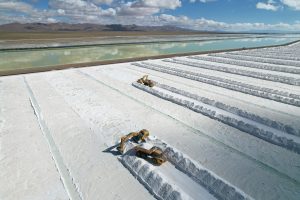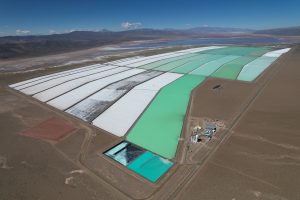The coming electric battery revolution in America will require billions upon billions of gallons of water to mine lithium – and many of the new U.S. mines will be located in the drought-prone American West. An investigative report from the Howard Center at Arizona State University. Find more stories from the project here and here.
- Slug: Howard Center-Lithium Argentina. 1,595 words.
- Photos available (thumbnails, captions below).
By Francesca D’Annunzio, Anna Montoya-Gaxiola and Alex Appel
Howard Center for Investigative Journalism
One of North America’s lithium mining powerhouse companies has lobbied for a record $1 billion Department of Energy low-interest loan — despite having never owned or operated any kind of mine in the U.S.
By last September, Vancouver-based Lithium Americas Corporation had begun talks with the U.S. government to obtain the loan to underwrite the cost of building a massive lithium mine in Nevada at Thacker Pass.
While the company has no prior experience operating in the U.S., it did previously own and later jointly operate an Argentinian lithium mining company, Minera Exar, that for years failed to comply with legal requirements to report environmental data to local mining regulators, the Howard Center for Investigative Journalism at Arizona State University found.
A history of non-compliance
The record of Minera Exar’s lack of adherence to environmental regulations in Argentina included failing to submit 14 required environmental monitoring reports to local Argentinian mining regulators between December 2012 and June 2016, according to documents released to the Howard Center by the provincial government transparency office in Jujuy province.
In 2016, the province’s Secretary of Mining and Hydrocarbons office fined Minera Exar more than 3 million Argentine pesos, or the equivalent of more than $200,000 in U.S. currency. The fine followed repeated “non-compliance” with rules requiring the sharing of data about the project’s impact on the environment.
The documents the Howard Center obtained say the missing environmental reports were meant to help the government track changes to natural resources like water, air, ground, flora and fauna in the area.
Minera Exar’s lithium mining operation is set up on a sprawling campus in a remote corner of northwest Argentina, where white sheets of salt spread across the rugged, red terrain.
The Cauchari and Olaroz salars, salt encrusted flats or depressions that scientists believe could be left over from evaporated lakes, are in the Atacama Plateau. The area is an arid region in the Andes Mountains that includes northwest Argentina. It is part of an area known as the “Lithium Triangle,” due to its abundance of the mineral. The tri-country area is located where Argentina, Bolivia and Chile meet, and it is one of the most lithium-rich regions in the world, according to the U.S. Geological Survey.
In July 2021, University of Buenos Aires hydrologist Marcelo Sticco was the lead author of a study that found the extensive “salinization of underground freshwater reserves” in the same province the mine operates. The study, titled “Environmental impacts of lithium exploitation in the wetlands and water resources of the Altiplano,” was published by the environmental advocacy group Wetlands International.
According to a Lithium Americas’ 2020 technical report, filed with the U.S. Securities and Exchange Commission, the Minera Exar mine will also cause the groundwater levels in areas near the mine to decline by more than 130 feet over the course of the 40-year project. The aquifers are filled with salty, lithium-heavy waters. The 130-foot drop in the aquifer is forecast to occur across an area the size of approximately 10 square kilometers, according to a map the company provided regulators., Smaller but still measurable impacts on water levels are predicted to happen across an area more than 25 kilometers wide.
The separate, 2021 study by Sticco, which examined projects across the Lithium Triangle, concluded that in general sinking water tables near any lithium mines in the Triangle could irreversibly contaminate fresh water with salty, lithium-rich waters.
“It’s like a slow violence against Indigenous peoples,” said Helle Abelvik-Lawson, a project officer at the University of London’s Human Rights Consortium, who interviewed community members and government mining officials for her doctoral thesis. Abelvik-Lawson noted “these are extremely dry areas” and said “any dropping water supplies whatsoever could be devastating.”
What happened in Argentina, should stay in Argentina?
Minera Exar did not respond to multiple emails or a request for an interview that was physically delivered by a paralegal to the company’s headquarters in Argentina.
The Howard Center also attempted to reach Lithium Americas. A spokesperson for Lithium Americas, Tim Crowley, declined to comment on anything related to Minera Exar’s operations in Argentina. Lithium Americas recently created a new corporation in October 2023 which Crowley said had no relation to the ‘Lithium Americas’ that formerly operated Minera Exar. Lithium Americas’ website describes a “separation” in which “the former Lithium Americas Corp. reorganized into two independent publicly traded companies” in October: Lithium Argentina and Lithium Americas. Crowley declined to speak on behalf of the former company, and referred reporters to Lithium Argentina for comment about Minera Exar.
“The two companies are completely separate with no interconnection,” said Crowley. “As such, it would not be appropriate for us or our management team to comment on your inquiries.”
The new, post-October 3 Lithium Americas bears the same name that the former company had since 2009. The new Lithium Americas also shares the same Internet domain name as the former company, the same logo and the same three letter ticker on the New York and Toronto stock exchanges. In September — before the split — the former Lithium Americas had the same CEO and CFO as the present Lithium Americas. But Crowley, the spokesperson for the new company, declined to discuss past responsibilities those executives, or the previous Lithium Americas had while overseeing Minera Exar and its lithium mine in Argentina.
“Frankly, we find it questionable that you continue to contact us about this matter instead of going to the actual present and historical owner and its principals,” emailed Crowley, while forwarding reporters to speak with Lithium Argentina.
The Howard Center emailed Lithium Argentina, and FedExed an overnight request to speak with the president and interim CEO of Lithium Argentina, John Kanellitsas, who is also the former president of Lithium Americas. The letter was delivered to the Vancouver, Canada headquarters of Lithium Argentina, according to FedEx tracking. Lithium Argentina’s headquarters is located in the same Vancouver, Canada office building as the headquarters for Lithium Americas. One company is located in Suite 300, the other, Suite 400. No one from Lithium Argentina replied to the Howard Center’s requests for comment.
Poverty and prosperity in La Puna
La Puna, a region in northwestern Argentina that includes a salt desert and one of the largest salt flats in the world, includes the provinces of Jujuy, Salta, and Catamarca. The high-altitude area has become a tourist destination and is full of animals, lagoons and vegetation, according to Visit Argentina, a travel website hosted by Argentine tourism officials.
When Vilma Cañari was growing up in nearby Olaroz Chico in the 1990’s, the buildings in her neighborhood did not have lights. Instead, her family and neighbors used candles and burnt mule dung to illuminate their surroundings.
In May 2022, in a YouTube video for Argentine entrepreneurs, the company’s current president, Franco Mignacco, described lithium mining as “one of the great vehicles that can alleviate the problem of job creation.” And, he added, “the great scourge that is poverty in our country.”
Since the advent of lithium mining in the area, called the Susques department, the number of households that do not have their basic needs met had fallen by 25 percent, according to a 2019 Jujuy government report on the economic impacts of all kinds of mining taking place in Jujuy. Most of the area remains poor, by many measures. According to the 2022 Argentinian census, less than 2 percent of private households have access to gas or electricity for cooking, and less than half have internet access at home.
In contrast, lithium mine executives like Minera Exar CEO Franco Mignacco have become wealthier since the company came to town in 2009. Mignacco became a Lithium Americas director in 2009, in addition to his role running subsidiary Minera Exar. The value of shares of Lithium Americas stock he owns or controls have more than doubled in value since that time, increasing from more than $7.3 million USD in 2009 to nearly $18.8 million USD as of October 2023, according to documents filed with U.S. and Canadian securities regulators.
The Howard Center emailed Minera Exar, and also hired a paralegal to hand-deliver requests for an interview to Mignacco at the company’s headquarters in San Salvador de Jujuy, Argentina. A Minera Exar representative signed for the hand-delivered letter on December 20. Neither Mignacco nor a company representative replied to reporters’ inquiries.
An uncertain future
Nowhere — including the U.S. — is prepared for the regulatory challenges of the impending lithium boom, according to Aimee Boulanger, executive director of the Initiative for Responsible Mining Assurance.
“There is not a country in the world right now with laws sufficient to prevent significant harm where mining happens — not one,” Boulanger said. That includes wealthier countries with more robust regulations, such as the U.S. and Canada, Boulanger added.
IRMA is a global industry organization that conducts independent assessments of all types of mines across the world, which also developed a voluntary global set of standards to fill the void of missing government regulations.
Scrutinizing companies and mining laws in the early stages of the lithium boom is particularly important, environmental advocates say. The aspiring lithium mining giants — including Lithium Americas — “could be the Chevrons and BPs and Shells of the future,” Abelvik-Lawson said.
This story was produced by the Howard Center for Investigative Journalism at Arizona State University’s Walter Cronkite School of Journalism and Mass Communication, an initiative of the Scripps Howard Fund in honor of the late news industry executive and pioneer Roy W. Howard. For more see https://azpbs.org/lithium. Contact us at howardcenter@asu.edu or on X @HowardCenterASU.

